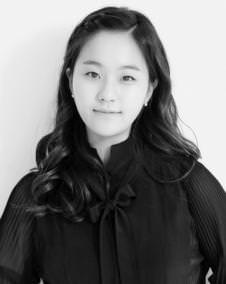Somebody must have rung a bell and instructed judges at all international music competitions to start awarding prizes to young classical musicians who already demonstrate daring and panache, even at the expense of perfect accuracy and tone.
It’s a welcome development if the thought is that absolute noteworthiness can be achieved later but musical personality can’t, rather than starting with classically rounded polish and trying to append some style later. That was very much on display Sunday afternoon at the Phillips Collection as Korean violinist Ji Young Lim, winner of the 2015 Queen Elisabeth International Competition in Brussels, performed a globetrotting recital of Germanic, Norwegian, French, and American masterworks.
Ms. Lim’s recital was a remarkable bookend to an appearance last month in Washington of the competition’s silver medalist, Ukrainian violinist Aleksey Semenenko. Ms. Lim brought different strengths and challenges to her repertoire, with a chocolatey tone in lower registers and an intense vibrato at higher notes, compared to Mr. Semenenko’s steely, almost percussive approach to his violin playing. There’s certainly room for both on the international concert circuit and it will be fascinating to see how both develop.
At the Phillips, Ms. Lim was on surest ground in the Sonata No. 2 in A Major for Violin and Piano by Johannes Brahms. She delivered a veteran-level performance of this relatively late work by Brahms, in which he had discarded most of his overwrought approach to his early chamber music works, which often try too hard to sound like imitation symphonies. This sonata goes straight for the melody, opening with a tune whose first few notes sound remarkably like a theme from Richard Wagner’s opera Die Meistersinger, somewhat exploding a strict division between the late 19th century styles of supposed archrivals Brahms and Wagner.
This melody played directly into Ms. Lim’s talent for low and middle-range sound production. Her tone is remarkably “present” and it’s no exaggeration to say that the sound almost makes you sit up and say “hello!” New melodies later in the first movement and in the third and final movement intensified the experience. An unusual second movement which inserts fast “scherzo” fingerwork and bowing gave Ms. Lim a chance to show the kind of virtuoso technique that got her into the finals of the Queen Elisabeth and that repeatedly came into play later in the Phllips recital.

Ms. Lim’s victory in the competition also earned her concert dates with one of the world’s leading collaborative pianists, Rohan de Silva. Mr. de Silva’s elegant performance with Ms. Lim of the Brahms sonata alone was practically worth the price of admission.
The specific national traditions at play in much of the rest of the recital showed where this young violinist probably can continue to deepen her study. One of Norwegian composer Edvard Grieg’s masterpieces outside of the symphony hall is his Sonata No. 3 in C minor for Violin and Piano. It’s notable for a Scandinavian folk-dance lilt in its third movement that gets batted between the two instruments and modulates through a variety of keys.
Ms. Lim did not entirely succeed at folding her lines into the interplay between violin and piano, at one point appearing to try to drown out the piano (amazing as that may seem for a violin) with an accompaniment in octaves rather play off of her partner. She certainly has the chops for the rest of the piece, which in this case opens right at the bottom of the violin with an emotional melody and works its way up to the top of the instrument.
In one of her two encores, Ms. Lim and Mr. de Silva performed a virtuoso arrangement of George Gershwin’s “It Ain’t Necessarily So” from Porgy and Bess. For my money it was jazzy but not sultry, largely because they simply played it too fast. Ms. Lim also has a distinct way of performing slides between notes, which involves burrowing in on the low note (with a vibrato that mostly goes slightly under the core pitch) and then rapidly and suddenly moving to the top, rather than feeling her way through the meaning of the two notes. Imagining how a singer might execute this would probably alter her approach.
Ms. Lim’s high notes in other virtuoso moments, particularly a fantasy on Georges Bizet’s Carmen, were all over the map. When she hit them, the effect was glorious; when they were approximate, she moved straight onto the next musical moment with no sweat. One had the sense that she is using the time afforded her by her victory in a prestigious international competition – which guarantees her artist “management” and international recitals for a period of time – to explore approaches to her almost global repertoire on a low-risk basis

As if to prove the point, the Phillips recital opened with brief remarks from the ambassadors to the U.S. of both Belgium (which hosted the competition that Ms. Lim won) and South Korea. Notable were the remarks from Korean Ambassador Ahn Ho-Young, who emphasized the role of Ms. Lim’s principal conservatory in South Korea (where Western classical music is huge, as it is now in China) following long association and learning by past Korean entrants in the Queen Elisabeth Competition.
There’s been considerable discussion in the global musical press about the fact that Ms. Lim, unlike past Korean breakout classical artists, has been trained in her native country rather than going to live in Europe or the U.S. And even at that – major credit to the 20-year-old Ms. Lim for introducing her two encores to her American audience in perfectly serviceable English.
Running Time: Approximately two hours, with one 15-minute intermission.
Violinist Ji Young Lim performed on Sunday, November 1, 2015 at the Phillips Collection – 1600 21st Street NW, in Washington, DC. For upcoming Sunday Concerts at the Phillips, see their concert schedule.




